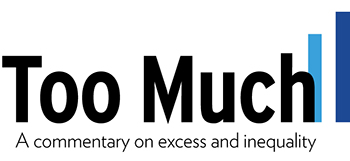The Democrats, once again, have chosen not to challenge the incredible concentrations of wealth that sit at America’s economic summit. These concentrations have consequences. We explore one — at General Motors.
By Sam Pizzigati
Ready to get in the mood for the quickly approaching Democratic Party national convention? Just click your way online to the draft 2008 Democratic Party platform. You’ll find, stuck inside, some stirring passages that make an eloquent case for change. But you won’t find, unfortunately, a single explicit line about what most needs changing in the United States today: America’s alarmingly top-heavy distribution of income and wealth.
This shouldn’t be particularly surprising. Over the past quarter-century, America’s richest 0.1 percent have tripled — and the richest 0.01 percent have quadrupled — their share of the nation’s income. Over this remarkable span of time, not one Democratic Party platform has suggested that American politics ought to concentrate on undoing this concentration.
 Unchallenged, this concentration just continues merrily along. America’s most affluent 400 took home an average $214 million in 2005, the most recent year with figures available. A half-century ago, in 1955, the top 400 averaged, after adjusting for inflation, a mere $12 million.
Unchallenged, this concentration just continues merrily along. America’s most affluent 400 took home an average $214 million in 2005, the most recent year with figures available. A half-century ago, in 1955, the top 400 averaged, after adjusting for inflation, a mere $12 million.
What have the rich been doing to advance so handsomely?
“The standard explanation,” UCLA economist Sanford Jacoby noted this past spring in an insightful analysis of the dynamics that have left the United States so dangerously unequal, “has to do with market forces.”
The market is rewarding America’s corporate and financial elites, the story goes, for the economic value their smarts and skills create.
But these corporate and financial elites, Jacoby’s analysis shows, haven’t really been creating value. They’ve been extracting it.
“Executives and shareholders,” he notes, “take resources that otherwise would have been reinvested or returned to other factors of production” — research and development, for instance — and, in the process, leave companies less competitive in global markets.
This extraction of value enriches executives and America’s already wealthy — who own the overwhelming bulk of corporate stock — and, at the same exact time, enhances “income stagnation for the working poor and middle class.”
Last week, in the Chicago Tribune, Jacoby explored a concrete example of this extraction process — at General Motors, once the single most important corporation in the United States, the mighty engine of post-World War II American prosperity.
“As GM goes,” the old saw went, “so goes the nation.”
GM these days, daily headlines remind us, is not going particularly well. The company’s low-mileage Yukon and Suburban SUV’s are piling up unsold on lots across the United States. GM workers are losing jobs and benefits. Rumors about a GM bankruptcy have even started circulating.
The conventional wisdom from conservative circles blames GM’s current woes on high wages and pensions for workers. More perceptive critics, Jacoby notes, blame GM’s “overreliance on gas-guzzlers, mediocre product quality, and unimpressive design.”
But that overreliance didn’t have to be. In the 1990s, GM was swimming in cash, more than enough to match Toyota, or any other competitor, in innovative breakthroughs.
“So what in the world,” asks Jacoby, “did the company do with all its money?”
That money, simply put, went to making the rich richer, through maneuvers designed to reward both shareholders and company executives flush with stock options. From 1996 to 2000, GM spent $13 billion buying back its shares of stock on the open market, a move that increases “demand” for a company’s shares and jacks up the share price. GM spent $7 billion more on dividends to shareholders.
In those same years, Jacoby points out, Toyota “successfully resisted demands — chiefly from American investors — to raise its payout ratio” to shareholders. Toyota’s top executive in the late 1990s, the UCLA economist adds, believed that shareholder interests “would best be served if Toyota plowed its cash into research and development for hybrids and other long-term improvements.”
Toyota made investments in the future. GM put smiles on rich people’s faces.
The next occupant of the White House, to have any hope of restoring American prosperity, is going to have to stop the grinning,
Sam Pizzigati edits Too Much, the online weekly on excess and inequality published by the Washington, D.C.-based Institute for Policy Studies.



Discussion
No comments for “The Democratic Party Platform’s Missing Plank”